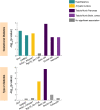This is a preprint.
Distinct and shared genetic architectures of Gestational diabetes mellitus and Type 2 Diabetes Mellitus
- PMID: 36865330
- PMCID: PMC9980250
- DOI: 10.1101/2023.02.16.23286014
Distinct and shared genetic architectures of Gestational diabetes mellitus and Type 2 Diabetes Mellitus
Update in
-
Distinct and shared genetic architectures of gestational diabetes mellitus and type 2 diabetes.Nat Genet. 2024 Mar;56(3):377-382. doi: 10.1038/s41588-023-01607-4. Epub 2024 Jan 5. Nat Genet. 2024. PMID: 38182742 Free PMC article.
Abstract
Gestational diabetes mellitus (GDM) affects more than 16 million pregnancies annually worldwide and is related to an increased lifetime risk of Type 2 diabetes (T2D). The diseases are hypothesized to share a genetic predisposition, but there are few GWAS studies of GDM and none of them is sufficiently powered to assess whether any variants or biological pathways are specific to GDM. We conducted the largest genome-wide association study of GDM to date in 12,332 cases and 131,109 parous female controls in the FinnGen Study and identified 13 GDM-associated loci including 8 novel loci. Genetic features distinct from T2D were identified both at the locus and genomic scale. Our results suggest that the genetics of GDM risk falls into two distinct categories - one part conventional T2D polygenic risk and one part predominantly influencing mechanisms disrupted in pregnancy. Loci with GDM-predominant effects map to genes related to islet cells, central glucose homeostasis, steroidogenesis, and placental expression. These results pave the way for an improved biological understanding of GDM pathophysiology and its role in the development and course of T2D.
Conflict of interest statement
Competing Interest Statement R.W. has received honoraria from The Jackson Laboratory and sponsored travel from the Russell Sage Foundation A.P. is the chief scientific officer for the FinnGen project that has funding from 13 pharmaceutical companies. M.J.D is a founder of Maze Therapeutics. The remaining authors have no competing interests to declare.
Figures



References
-
- ACOG Practice Bulletin No. 190: Gestational Diabetes Mellitus. Obstetrics and Gynecology 131, e49–e64 (2018). - PubMed
-
- Wang H., Li N., Chivese T., Werfalli M., Sun H., Yuen L., Hoegfeldt C.A., Elise Powe C., Immanuel J., Karuranga S., Divakar H., Levitt N., Li C., Simmons D., Yang X. & Group, I.D.F.D.A.C.H.i.P.S.I. IDF Diabetes Atlas: Estimation of Global and Regional Gestational Diabetes Mellitus Prevalence for 2021 by International Association of Diabetes in Pregnancy Study Group’s Criteria. Diabetes Research and Clinical Practice 183, 109050 (2022). - PubMed
-
- Bellamy L., Casas J.P., Hingorani A.D. & Williams D. Type 2 diabetes mellitus after gestational diabetes: a systematic review and meta-analysis. Lancet 373, 1773–9 (2009). - PubMed
-
- Dennison R.A., Chen E.S., Green M.E., Legard C., Kotecha D., Farmer G., Sharp S.J., Ward R.J., Usher-Smith J.A. & Griffin S.J. The absolute and relative risk of type 2 diabetes after gestational diabetes: A systematic review and meta-analysis of 129 studies. Diabetes Res Clin Pract 171, 108625 (2021). - PMC - PubMed
Publication types
Grants and funding
LinkOut - more resources
Full Text Sources
